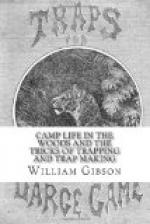When everything is thus prepared, the hunters start out into the adjacent woods and willows, and drive their game toward the nets. This is generally an easy matter, and, no sooner do the birds come in sight of the heap of gravel, than they fly towards it en masse, and the ground beneath the net is soon covered with the hungry game. [Page 76] The hunter then goes to the end of the line, and, with a sudden pull, hauls down the stakes: the net fans over the birds, and they are prisoners.
Hundreds of ptarmigan are often thus caught by a single sweep of the net. The trap is simply arranged, and may be constructed on a reduced scale for smaller birds, if desired.
THE TRAP CAGE.
[Illustration]
Among bird-catchers generally, this is the favorite and most universal trap; and, where a decoy bird is used, it is particularly successful. The cage is arranged in two compartments, [Page 77] one above the other,—the lower one being occupied by the call-birds. The making of the cage requires considerable ingenuity and much patience; and, for the benefit of those who may desire to exercise that patient ingenuity, we will subjoin a few hints, which may help them along in their efforts. For an ordinary cage, the height should be about one foot, the broad sides the same, and the top and other two sides eight inches. First cut four corner uprights. These should be three-quarters of an inch square, and one foot in length. Next cut a bottom board of pine, twelve inches by eight inches, and one inch in thickness. From each of its corners, cut a small cube of the wood, exactly three-quarters of an inch square, thus leaving four notches, which will exactly receive the ends of the uprights, as seen at (a). Before adjusting these pieces, the four sides of the boards should be pierced with small holes, as is also shown in the diagram (a). These may be punched with a brad-awl, and should be about half an inch apart, and three-eighths of an inch from the edge of the board. Each one of the uprights may then be secured in place by two long




